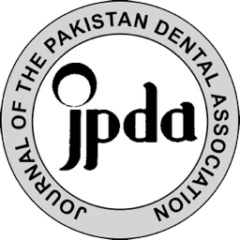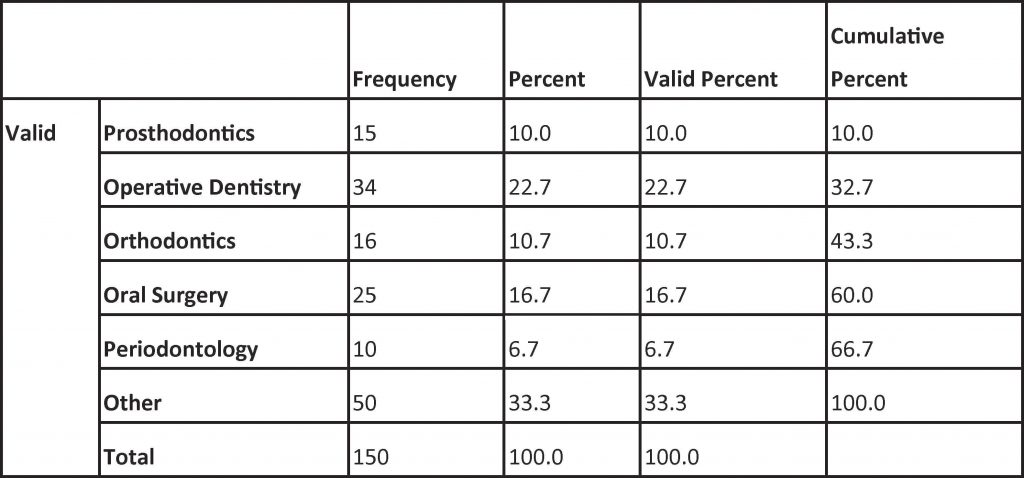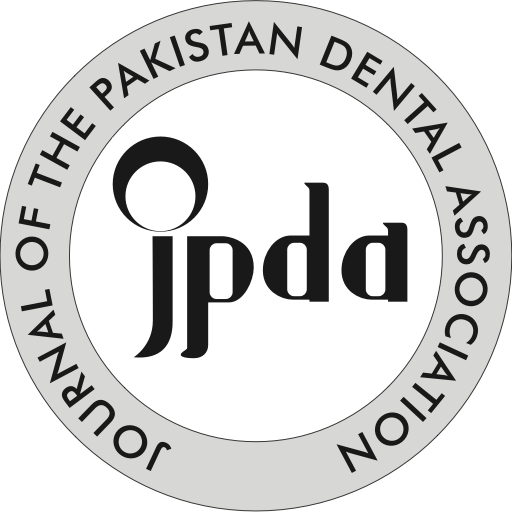
Haroon Rashid1Â Â Â Â Â Â Â Â Â Â Â Â Â Â Â Â Â Â BDS, MDSc
Mustafa Naseem2Â Â Â Â Â Â Â Â Â Â Â Â Â Â Â Â Â Â BDS, MDPH
Fahim Vohra3                   BDS, MFDS, M.Clin.Dent, MRDRCS
Saeed Ullah Shah4Â Â Â Â Â Â Â Â Â Â Â Â Â Â Â Â Â BDS
Amir Shehzad5Â Â Â Â Â Â Â Â Â Â Â Â Â Â Â Â Â Â Â Â BDS
OBJECTIVE: To gather baseline data about different prosthodontic treatments provided by the dental practitioners belonging to various specialties of dentistry, residing in Karachi, Pakistan.
METHODOLOGY: A total of 150 self-designed-structured anonymous questionnaire in English language were included. The questionnaire comprised of three sections which included questions regarding the age, gender, years of experience and type of dental practice, the number of patients treated in a month by the GDP for different dental prosthesis and questions regarding the perceived change in the provision of dental prosthesis. Descriptive statistics and analysis of the collected data was performed using Statistical Package for Social Sciences (SPSS) version 21 (SPSS, Chicago, Illinios, USA).
RESULTS: A large number of respondents (84.6%) reported that the number of complete denture prosthesis provided to the patients were either increasing or not changing. A total of 81.4% reported activity in RPDs to be either ”increasing” or ”not changing”. With regard to the prosthesis supported by implants, very low number of respondents reported this practice was declining.
KEY WORDS: Dental practitioners, Prosthodontic referrals, Prosthodontic restorations, Implant supported prosthesis
HOW TO CITE: Rashid H, Naseem M, Vohra F, Shah SU, Shehzad A. Prosthodontic services provided by the Dental Practitioners of Karachi, Pakistan. J Pak Dent Assoc 2014; 23(4):159-163
INTRODUCTION
Over the past two decades, provision of dental services has massively evolved in Pakistan. Dental practitioners predominantly treat the majority of patients with the need for tooth replacement, to the extent that very few patients are referred to specialist prosthodontists. These changes have partly occurred due to a lack of an established referral system among general dental practitioners (GDPs) and partly due to advancements in material sciences, dental equipment, clinical techniques and treatment planning 1,[1]. Treatment planning is one of the critical aspects of undergraduate and postgraduate dental education and thus, has played its major role[2].
Edentulism in Pakistan occupies an estimated 4.1% of the total population aged 65 years and above, with a projected increase to 9.3% by 2030[3]. Since there has been an increase in the life expectancy of elderly individuals, prosthodontic treatment needs and thus, the number of adults over the age of 65 years seeking dental treatment has increased[4],6. Statistics related to dental practice among European countries has shown private dental practitioners providing higher fixed prosthodontic treatments as compared to dentists in the public sector. By contrast, dentists in public health care report provision of higher number of removable prosthesis fabricated7. A similar trend of decrease in the provision of removable prosthesis as compared to fixed prosthesis among developing countries has been observed8,9. Furthermore, it has been estimated that the requirment for removable partial and complete denture prosthesis may surpass the provision of these prosthesis by oral health care professionals during the upcoming 20 years 10,11.
The provision of removable prosthesis for elderly patients (more than 50 years) is much common as compared to young adults (20-50 years). While selecting the available prosthodontic treatment options, dental practitioners usually consider age, gender, socio-economic status, educational level, oral health status and patients concerns and wishes12. Moreover, span of edentulous ridge, the ridge types, the soft and hard tissue conditions usually determine the type of prosthesis to be fabricated. Whilst many factors are involved which may influence the outcome of prosthodontic treatment, aesthetics has always been one of the primary patient concern regarding prosthodontic replacement of teeth.
Contemporary treatment approaches such as implantsupported prosthesis has gained considerably during the past decade13. Surgical implant placements are relatively easy to perform and in experienced hands may take less than sixty minutes14. Implant supported prosthesis offer better retention and stability, however due to lack of patient awareness and implant education in Pakistan, this treatment modality is gaining popularity very slowly. A major concern for patients in need of implant retained restorations is the high cost of this treatment modality.
A baseline data related to the prosthodontic practices among practicing dentists in any population is critically important. From our knowledge from indexed literature there are no studies that report the trends in prosthodontic practices among GDPs in a Pakistani population. Such data is vital for understanding the current patterns in practice of GDP and for planning of widespread oral health care for the population. The purpose of the current survey was to gather baseline data about the different prosthodontic treatment practices among the dental practitioners belonging to various specialties of dentistry, residing in Karachi, Pakistan.
METHODOLOGY
The study population in this cross-sectional study was a sample of dentists in Karachi, Pakistan. Along with practitioner of various specialties, GDPs included in the study were graduate dentists and were currently employed, owning or working in private practice, must have two years of experience after basic dental qualification and also have a valid dental council (PMDC) practicing license. The Ethical Committee of College of Dentistry, Ziauddin University approved the study protocol and the study was conducted from December 2014 to February 2015. A self-designed-structured anonymous questionnaire in English language was used as the instrument for data collection. The questionnaire comprised of three sections:
- Section one had four questions regarding the age, gender, years of experience and type of dental practice.
- Section two enquired about the number of patients treated in a month by the GDP for different dental prosthesis. The dental prosthesis included, crowns, fixed partial dentures (FPD), acrylic and cast partial dentures, complete dentures and implant supported crowns, FPD and dentures.
- Section three of questionnaire contained questions regarding the perceived change in the provision of dental prosthesis by the GDP in the last year (either positive or negative).
A pilot questionnaire distribution was performed among sixteen currently employed dentists in a tertiary care hospital to check the validity of the questionnaire. Sampling of tertiary care centers was done using simple random probability sampling method. From total of eleven tertiary care hospitals in the city six were randomly selected. Five hundred questionnaires along with a letter stating about the instructions, rationale and intention of the survey, were randomly distributed. Students of the research group collected data through personal visits to six dental institutions of Karachi. Descriptive statistics and analysis of the collected data was performed using Statistical Package for Social Sciences (SPSS) version 21 (SPSS, Chicago, Illinios, USA).
RESULTS
Fifty forms were rejected as they had incomplete responses. Out of the 500 surveys distributed, 150 questionnaires from practicing dentist were considered eligible for study. The response rate was 30 percent. Table 1 displays the distribution of the various specialties in dentistry represented by the respondents. Among the total respondents, 15.5% (n = 23) of participants belonged to teaching hospitals only and 84.6% (n = 127) practiced at both places (private practice and teaching hospital) (Table 2).
Table 3 displays perception of the dentists about the changes in provision of complete denture prosthesis for the patients. 82% reported that provision of complete dentures for their patients is either ”increasing” or ”not
LIST OF TABLES:
 Table-1: Distribution of Specialties in Dentistry among the respondents
Table-1: Distribution of Specialties in Dentistry among the respondents
 Table-2: Practicing Position of the respondents
Table-2: Practicing Position of the respondents
 Table-3: Trends in Complete Denture cases
Table-3: Trends in Complete Denture cases
 Table 4: Trends in Removable partial denture (RPD) cases
Table 4: Trends in Removable partial denture (RPD) cases
 Table 5: Trends in Implant cases
Table 5: Trends in Implant cases
changing”. Respondent’s perception regarding the changes in removable partial denture therapy for their patients is shown in Table 4. 81.4% dentists reported that the activity in RPDs was ”increasing” or ”not changing”. As far as the implant-supported prosthesis (fixed and removable), very few numbers of the respondents (8%) reported that the service was ”decreasing” as shown in Table 5.
DISCUSSION
In the current survey, the rate of response of the questionnaires which were returned were low (30%) and the sample size of the current study can be termed limited. Although the sample collection involved only a single city, the hospital settings in the current study offered better facilitation for the data collection. The findings from the current survey can be termed restricted as it involved only dental practitioners of Karachi in selected areas. However; the sample size could be improved in future studies by targeting further localities in Sindh province. It is worth mentioning that in teaching hospitals, the preference for a particular type of prosthesis provided by the dentist is limited as compared to private practices. Lack of financial constraint for some patients, allows the dentist to execute ideal treatment plans for the patients.
The results of the current study showed that only 10% of the responding dentists belonged to the speciality of prosthodontics. Rest of the practitioners belonged to other specialties and were providing prosthodontic services on their own. Many studies have shown that the practitioners usually spend most of their time treating adults themselves and refer a very small number of
patients to specialist prosthodontists3,4,15,16,17 and confirms that many treatments involve fixed restorations. A study was conducted by Ellis et al18 which focused on referrals to the restorative department of a general hospital in Europe. Their results indicated that referrals for prosthodontic treatment were low as compared to the referrals requests for endodontic and periodontal treatments. One possible explanation for the low referrals could be that the present study was conducted in Karachi city where the number of practicing specialist prosthodontists is low in comparison to specialists of other dental specialties (such as operative dentistry, orthodontics and oral surgery)19.
Although implants are not placed by most of the dentists, some of them did provide restorations over implants. In the present study, the respondents indicated growing activity in implant dentistry, with only 8% seeing a decrease in implant-supported FPDs and implantretained removable dentures. One possible explanation for these findings is the increased emphasis being put on implant training and continued professional training courses by implant companies and institutes at present for dental practitioners. it is worth noting that the majority of respondents were practicing in institutions and teaching hospitals, these individuals are known to be better connected to training and education related to innovations in dentistry and are exposed to better opportunities for development of clinical skills. Dental implants were introduced around 40 years ago and have been the focus of research in the field of dentistry20. Levin P21 stated that the field of implant dentistry will grow at moderately low levels unless certain changes are made. His findings suggested that only 40% of the restorative dentists take up or participate in a case that involves implant prosthodontics.
The increasing trends of implant dentistry indicate a need for training and education not just for practitioners but also for undergraduates in relation to dental implants22. A comprehensive knowledge of diagnosis and treatment options in implant dentistry should be mandatory for undergraduate dental students23.
Most of the respondents reported providing removable prosthodontic services and only 18% reported a decrease in complete denture treatment and 18.7% reported a decrease in RPD treatment. The use of removable dentures in Europe has declined possibly due to fall in the rates of Edentulism24 and it seems that having artificial denture teeth is becoming less socially acceptable25. Some studies have suggested that the need for removable prosthesis (partial and complete) will actually increase with time and it is likely that this demand will exceed the supply of dentists during the next 20 year period6,27.
Furthermore it is worth mentioning that oral health diseases could be prevented and loss of teeth can be minimized by establishing innovative dental public health programs for the dental community27.
CONCLUSIONS
Dental practitioners in Karachi are continuing to provide significant number of removable partial dentures, removable number of fixed prosthodontic restorations and provide a limited number of implant supported prosthesis. The provision of Implant supported restorations is showing a gradual increase. The practice patterns and trends which were revealed in the current survey surely has potential implications for private dental practitioners, the patients seeking prosthodontic treatment, curriculum of dental schoolsand dental continuing education programs.
REFERENCES
- Joshi A, Douglass CW, Feldman H, Mitchell P, JetteA. Consequences of success: do more teeth translate into more disease and utilization? J Public Health Dent 1996;56:190-197.
- Manski RJ, Goodman HS, Reid BC, Macek MD.Dental insurance visits and expenditures among older adults. Am J Public Health 2004;94:759-764.
- Hook CR, Comer RW, Trombly RM, Guinn JW 3rd, Shrout MK. Treatment planning processes in dental schools. J Dent Educ.2002;66:68-74.
- Butt AM, Ahmed B, Parveen N, Yazdanie N (2009) Oral health related quality of life in complete dentures. Pak Oral & Dent J 30:397-402
- Beck CB, Bates JF, Basker RM, Gutteridge DL,Harrison A (1993) A survey of the dissatisfied denture patient. Eur J Prosthodont Restor Dent 2, 73-78.
- Manski RJ, Moeller JF, Maas WR. Dental services. An analysis of utilization over 20 years. J Am Dent Assoc 2001;132:655-664.
- Kronstrom M, Palmqvist S, Soderfeldt B, CarlssonGE. Dentist-related factors influencing the amount of prosthodontic treatment provided. Community Dent Oral Epidemiol 2000; 28:185-194.
- Kronström M, Palmqvist S, Söderfeldt B. Changes indental conditions during a decade in a middle-aged and older Swedish population. Acta Odontol Scand. 2001 Dec; 59:386-389.
- Hugoson A, Koch G, Göthberg C, Helkimo AN, LundinSA, Norderyd O, Sjödin B, Sondell K. Oral health of individuals aged 3-80 years in Jönköping, Sweden during 30 years (1973-2003). II. Review of clinical and radiographic findings. Swed Dent J. 2005; 29:139-155.
- Douglass CW, Shih A, Ostry L. Will there be a need for complete dentures in the United States in 2020? J Prosthet Dent 2002; 87:5-8.
- Douglass CW, Watson AJ. Future needs for fixedand removable partial dentures in the United States. J Prosthet Dent 2002; 87:9-14.
- Ghani F, Khan A.U. Factors influencing the type ofprosthetic restoration for partially dentate adults. JPMI 2010, Vol 24. No 01. 13-21.
- Al-Shammari KF, Al-Khabbaz AK, Akar MH, AlAnsari JM, Wang HL. Implant recommendation as a replacement option after tooth loss for periodontal reasons. Implant Dent. 2006; 15:104-110.
- Vohra FA, Rashid H. Implant retained as first choice of care for edentulous mandibles: a presentation of two cases. J Pak Dent Assoc 2012; 21: 182-187.
- Fenlon MR, Glick S, Sherriff M. An audit of lettersof referral to a prosthodontic department in a dental teaching hospital. Eur J Prosthodont Restor Dent. 2008; 16:128-131.
- Nash KD, Benting DG. Private practice ofprosthodontists in the United States: results from the 2008 & 2011 surveys of prosthodontists. J Prosthodont. 2014;23:10-20.
- Nash KD, Pfeifer DL, Sadowsky SJ, Carrier DD.Private practice of prosthodontists: current conditions of practice in the United States. J Prosthodont. 2010; 19:175-186.
- Ellis SG, Ashley MP, Deans RF. A survey of referralsto a restorative dentistry department in a district general hospital. Eur J Prosthodont Restor Dent. 2001;9:5966.
- Ghani F. Prosthodontics As A Dental Specialty InPakistan: Reflections On Its Historical Developments, Achievements And Future Plans. JPPA 2013; 01:6572
- Laura Gaviria, John Paul Salcido, Teja Guda, andJoo L. Ong. Current trends in dental implants.J Korean Assoc Oral Maxillofac Surg. 2014;40:50-60.
- Levin RP. Determining factors for implant referralrates. Implant Dent. 2002;11:312-314.
- Lang NP1, De Bruyn H; 1st European ConsensusWorkshop in Implant Dentistry University Education. The rationale for the introduction of implant dentistry into the dental curriculum. Eur J Dent Educ. 2009;13 Suppl 1:19-23.
- Hicklin SP1, Albrektsson T, Hämmerle CH; 1stEuropean Consensus Workshop in Implant Dentistry University Education. Theoretical knowledge in implant dentistry for undergraduate students. Eur J Dent Educ. 2009;13 Suppl 1:25-35.
- Mojon P1, Thomason JM, Walls AW. The impactof falling rates of edentulism. Int J Prosthodont. 2004;17:434-440.
- Ainamo J. Changes in the frequency ofedentulousness and use of removable dentures in the adult population of Finland, 1970-80. Community Dent Oral Epidemiol. 1983;11:122-126.
- Sijan Poudyal, Ashwini Rao, Ramya Shenoy, andHarsh Priya. Utilization of Dental Services in a Field Practice Area in Mangalore, Karnataka. Indian J Community Med. 2010;35: 424-425.
- Wu B, Liang J, Landerman L, Plassman B. Trendsof Edentulism Among Middle-Aged and Older Asian Americans. Am J Public Health. 2013; 103:e76-e82.
- Assistant Professor, Department of Community Dentistry, Ziauddin College of Dentistry, Karachi, Pakistan.
- Assistant Professor, Department of Prosthodontics, King Saud University, Saudi Arabia.
- House Officer, Ziauddin College of Dentistry, Karachi, Pakistan.
- House Officer, Ziauddin College of Dentistry, Karachi, Pakistan.
Corresponding author: “Dr Haroon Rashid †< drh.rashid@hotmail.com >


